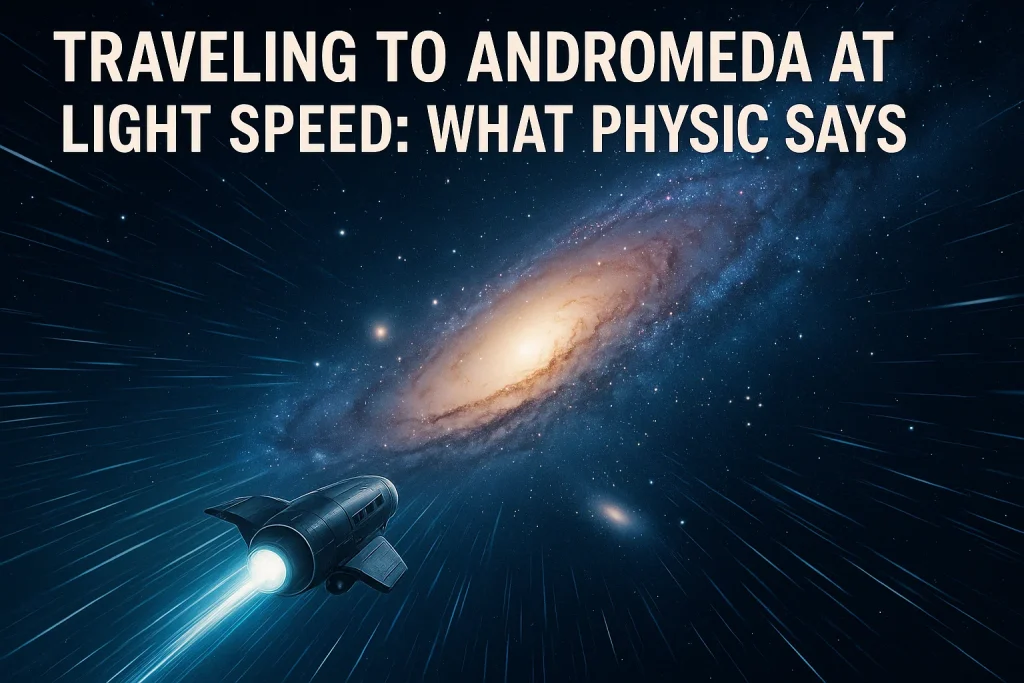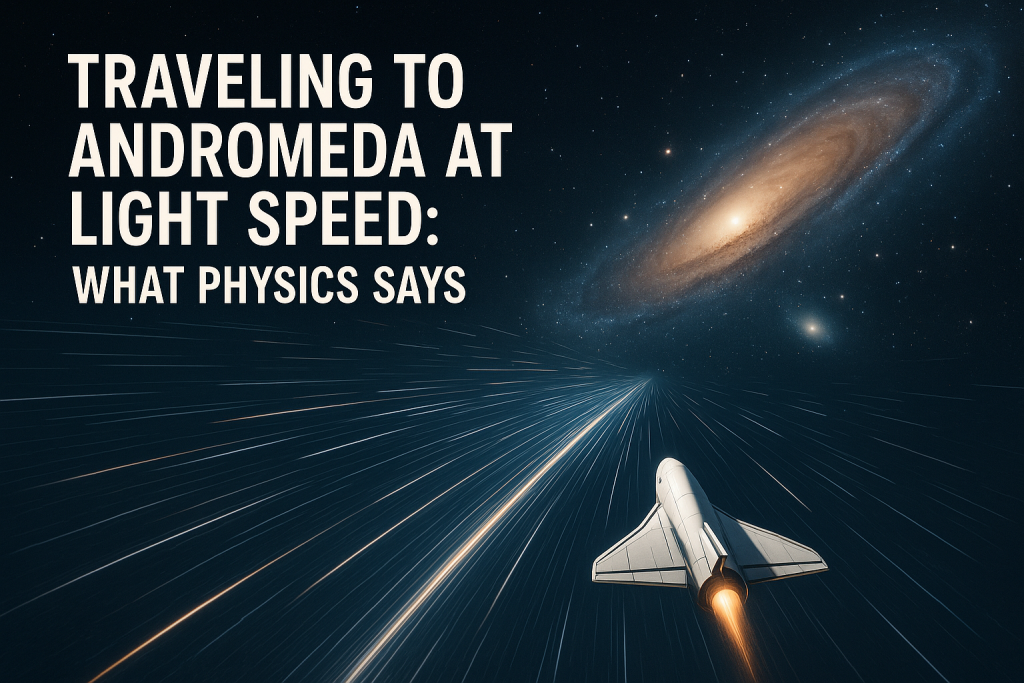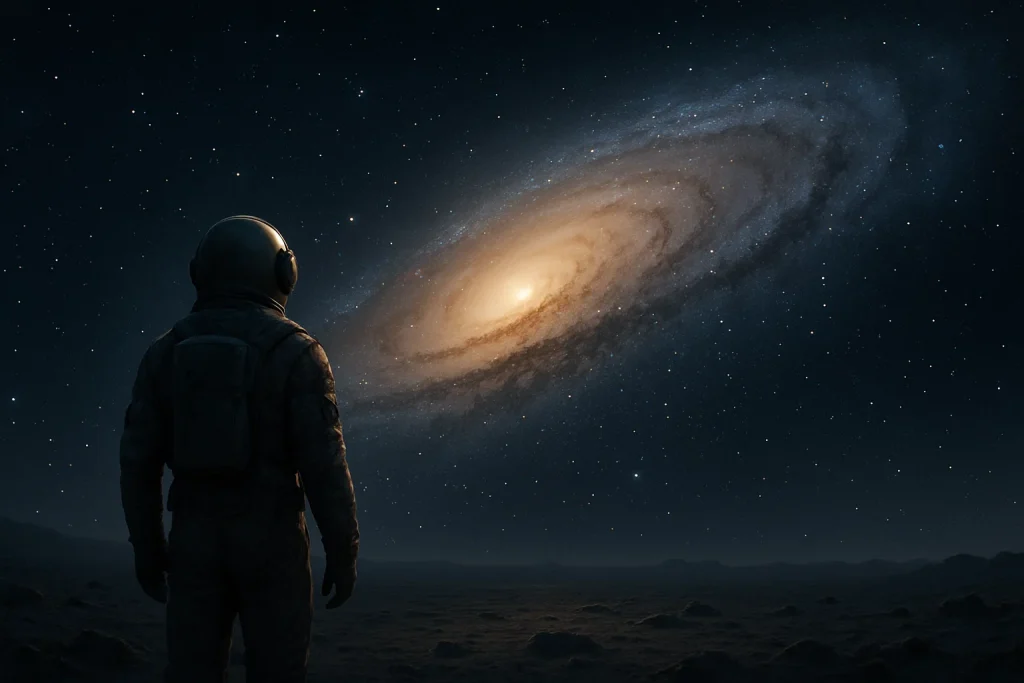⏲️ Estimated reading time: 7 min
🚀 Traveling to Andromeda at Light Speed: What Physics Says
📝 According to Einstein’s theory of relativity, reaching distant galaxies like Andromeda at near light speed might be theoretically possible. But while you can shrink distances in your frame, time dilation makes returning to Earth a one-way leap into the future.
Journey to Andromeda: The Mind-Bending Physics of Light-Speed Space Travel
In the age of interstellar dreams and science fiction turning into science fact, the question of traveling to faraway galaxies continues to capture the imagination of scientists, futurists, and space enthusiasts alike. One particular scenario offers a fascinating twist on space and time: what if you could travel to the Andromeda galaxy, two million light-years away, by approaching the speed of light?
As impossible as it may sound with our current technology, the laws of physics specifically Einstein’s theory of special relativity say that such a voyage is, in principle, achievable. But here’s the catch: while you might experience a journey lasting minutes, centuries or even millions of years would pass on Earth.
In this comprehensive post, we’ll explore:
- What the laws of physics say about faster-than-light travel
- Time dilation and length contraction explained
- The paradox of cosmic travel: forward in time, but never back
- What happens when you return to Earth
- Philosophical implications and the real limitations of relativity
- Could we ever talk to someone who traveled to Andromeda?
- Speculative tech and the future of time travel

🧠 Special Relativity 101: The Science Behind Light-Speed Travel
Before we jump into galactic voyages, it’s important to understand the basics of special relativity. Proposed by Albert Einstein in 1905, the theory dramatically changed how we perceive time and space.
At its core, special relativity says:
- The speed of light (299,792,458 m/s) is the ultimate speed limit.
- Time and space are not absolute they are relative to the observer’s frame of reference.
Two important consequences of this:
- Time Dilation: The faster you move, the slower time passes for you compared to someone at rest.
- Length Contraction: Objects traveling at speeds close to the speed of light appear shorter along the direction of motion.
🌌 Reaching Andromeda in Minutes?
Andromeda is approximately 2.537 million light-years from Earth. At first glance, this would seem like an insurmountable obstacle. Even if we could travel at 99.9999% the speed of light, wouldn’t it still take millions of years?
Not necessarily.
Due to length contraction, an astronaut traveling at near-light speed would experience distances being dramatically shortened. To that traveler, the trip to Andromeda might feel like it takes just minutes or hours even though millions of years pass for those back on Earth.
Let’s break this down:
- At rest: Earth to Andromeda = 2.537 million light-years.
- At 0.999999999999c (very close to light speed): Distance contracts in the traveler’s frame, possibly down to mere light-minutes.
- Time experienced by traveler: Minutes.
- Time experienced on Earth: Millions of years.
The closer you go to c (the speed of light), the more extreme the contraction.

⏳ The Downside: You Can’t Come Back (At Least Not Practically)
Here’s the cosmic catch.
Even if you could reach Andromeda in one minute of your own time, by the time you turned around and flew back at the same speed, over 4 million Earth years would have passed. Your return would be into a future Earth utterly unrecognizable, or perhaps long gone.
You’d be like a time traveler leaping into the future, unable to relay what you experienced back to your own people.
Why?
Because of time dilation:
- Your onboard clock moves slower than Earth’s.
- You age slowly; Earth races ahead.
- When you land back home, eons have passed.
This is not science fiction. It’s a direct consequence of the relativistic equations.
🧬 Thought Experiment: The Rocket to Andromeda
Let’s imagine a scenario.
- You board a spacecraft capable of maintaining 99.999999999% the speed of light.
- You accelerate toward Andromeda.
- Due to relativistic effects, you experience only 1 minute of travel time.
From your perspective:
- You blink and you’re there.
- Andromeda is within your grasp.
From Earth’s perspective:
- 2.537 million years pass before you arrive.
- Another 2.537 million years for your return.
Result: You’ve aged 2 minutes. Earth has aged 5 million years.
It’s poetic, tragic, and astonishing.
Why You Can’t Travel Backward in Time
This might prompt the question: “Can’t we build a time machine to go back?”
Sadly, current physics says no.
Time travel to the past would require either:
- Closed timelike curves (possible in theory, but highly speculative)
- Wormholes stabilized by fascinating matter (not proven to exist)
- Breaking causality (which would destroy the laws of physics as we know them)
So while flying near light speed lets you jump forward in time, returning to your origin in the past remains forbidden at least in known physics.
Einstein’s relativity doesn’t prevent moving forward into the future faster than others, but it strictly forbids reverse time travel. No rocket can bring you back to the moment you left.
💡 Philosophical Implications: What If You’re the Only Witness?
Imagine you’re the astronaut who took the leap.
You return to a world without humans, without civilization just fossils and dust. You’ve become the last witness of a long-forgotten Earth.
All you wanted was to explore the stars. But now, you are truly and utterly alone.
This brings to light one of the great paradoxes of relativistic travel:
- You can explore the galaxy.
- You can live a dream most never imagined.
- But you may never share it with anyone who knew you.
🛠️ Could We Build the Technology?
Let’s assume we solve the massive energy problems.
To reach 0.999999c, we’d need:
- Enormous energy (equal to multiple atomic bombs per gram of spacecraft)
- Protection from interstellar particles (each speck of dust would hit like a missile)
- Radiation shielding from blue-shifted cosmic rays
- Stable, long-term propulsion systems (e.g., antimatter drives or light sails)
Some speculative proposals:
- Alcubierre Drive: Warps space rather than accelerating mass.
- Laser-Sail Technology: Propels spacecraft using high-powered laser arrays.
- Fusion or Antimatter Propulsion: Offers immense energy output.
But none of this solves the time issue. Even if you arrive alive, Earth’s timeline moves on without you.
🧪 What Does Modern Science Say?
Modern physicists continue to test relativity and quantum mechanics for signs of loopholes:
- Searching for quantum gravity that may unify time into a different structure
- Studying entanglement for “instantaneous” communication across vast distances
- Exploring cosmic inflation models that might hint at multiverse-like timelines
But so far, Einstein is still winning.
The cosmic speed limit holds firm. Time only flows forward. And travelers to distant galaxies return as oracles of a forgotten world.
🎥 Pop Culture vs. Real Physics
Movies like Interstellar, Contact, and 2001: A Space Odyssey tackle these ideas brilliantly.
In Interstellar, time dilation near a black hole means hours for one character equals years for another.
In Contact, the protagonist experiences an interstellar trip lasting seconds, though hours of video are recorded with no visible movement mimicking relativistic discrepancies.
Science fiction often foreshadows science fact. But the emotional core remains:
- Time moves differently.
- Distance is malleable.
- Sacrifices are immense.
🧭 Final Thoughts: Should We Try?
The physics is there. The math checks out.
But are we ready to send someone into the cosmos, knowing they might return to a planet that no longer knows them?
Relativity gives us a universe full of possibilities but at a cost. It promises us speed, but takes away connection. It offers us the stars, but steals our time.
For now, these remain the dreams of physicists and poets.

🔔For more tutorials like this, consider subscribing to our blog.
📩 Do you have questions or suggestions? Leave a comment or contact us!
🏷️ Tags: light speed travel, Andromeda galaxy, time dilation, relativity, Einstein, space exploration, near-light speed, time travel, cosmic physics, interstellar travel
📢 Hashtags: #LightspeedTravel, #AndromedaMission, #RelativityExplained, #SpaceTime, #EinsteinPhysics, #TimeDilation, #GalacticTravel, #RocketScience, #CosmicVoyage, #OneWayTrip
🪐 Final Reflections
Traveling to Andromeda at nearly the speed of light is a real possibility in theory. The science is solid, but the emotional and societal implications are staggering. As humanity stares out into the void, we must ask ourselves not just if we can make the journey but if we’re prepared to never come back.
Only logged-in users can submit reports.
Discover more from HelpZone
Subscribe to get the latest posts sent to your email.

